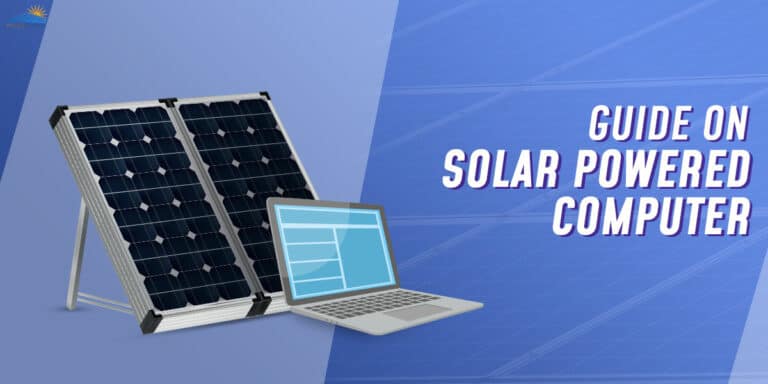Difference Between Solar Cell And Photodiode

Solar cells and photodiodes are both crucial parts of a solar panel or anything related to solar power. People are often confused between the two and what exactly they do. Unlike photodiodes, which simply convert light energy into electric charge, solar cells convert light energy to electrical energy.
Photodiodes are frequently found in electronics that use semiconductors to detect electromagnetic radiation, such as infrared or ultraviolet light. Solar cells, on the other hand, are used in the power industry because of their capacity to convert light energy into electrical current.
We shall discuss a photodiode’s definition, operation, and applications in this article and make the difference between solar cells and photodiodes very clear.
Solar Cell Explained
Solar cells are one of the fundamental devices used in any type solar panel ( Polycystalline or Monocrystalline ). While it is often confused with a photodiode, both are different and serve different purposes. To understand the difference between the two, let’s see what exactly a solar cell is.
What is A Solar Cell?

When exposed to light, a solar cell generates electricity. Silicon, which has a “very high” internal resistance, is used to create the most popular solar cells. As a result, they may generate usable levels of power for comparatively low voltages and currents, but at the expense of lower conversion efficiency of sunlight into energy.
How Does A Solar Cell Work?
When photons strike the solar cell’s surface, they knock electrons out of what is conceptualized as “holes” left behind when other electrons fall to lower energy levels within the material.
As a result, a “photo-generated current” is produced. The photo-generated current produces the induced voltage in the cell, which grows with greater photon energy.
The current that is extracted from the solar cells as a result of this generated voltage can travel through an external load to power gadgets or recharge batteries in electric vehicles.
What Are The Uses Of A Solar Cell?
While solar cells were limited and used exotically, solar cells or solar panels have become commonplace in household items and things like watches, calculators, and even powering houses.
Solar cells are wide and can be used with anything to generate power if used inventively. As a result, solar cells are employed in high-power applications such as spacecraft or satellites. Direct current electricity is generated by solar cells using the energy they absorb from sunlight and are typically joined together in an “array.”
In order to convert their output into alternating current for transmission and usage in homes and businesses, solar cells must be linked with an inverter, also known as a power converter.
Photodiode Explained
Now that you understand what a solar cell is let’s see what a photodiode is and how it works. Both are fundamentally different in their usages, function, and how it works. We will see how it is starkly different from a solar cell.
What is A Photodiode?

The semiconductor gadget known as a photodiode transforms light into current. Modern photodiodes are often silicon-based due to silicon’s “high internal resistance,” even though the earliest photodiodes were manufactured from germanium. Because of this characteristic, efficiency at high frequencies is increased, and dark current noise is reduced.
How Does A Photodiode Work?
The PN junction, which is the boundary between two different semiconducting materials, produces photo-generated charge carriers when exposed to sufficiently bright light.
The maximum number of electrons that may be gathered at once depends on the energy and wavelength of the illumination light. However, the majority of contemporary photodiodes only produce a few dozen electrons per photon of light.
Unlike normal diodes, which often have wire leads attached, photodiodes have been made with what are known as “front-side” contacts. When operating, this enables currents and voltages significantly higher than what conventional diodes, such as those found in photomultiplier tubes, can handle.
When light strikes the front of a solar cell’s PN junction, photon energy displaces an electron, which is collected by “holes” left behind when other electrons drop to lower energy levels within the material. This produces a “photo-generated current,” as the term is known.
What Are The Uses of Photodiodes?
Photodiodes are used to detect light in infrared, ultraviolet, and visible spectrums. They can also measure photoconductivity or photoresistance, which enables them to pick up both UV and ionizing radiation. However, the latter use has fallen out of favor due to worries about radioactive contamination.
In addition, photodiodes have a shorter response time as their surface area grows, which makes them ideal as sensors for detecting visible, infrared, or ultraviolet light. Photodiodes are also used in cameras, night-vision goggles, and other electronics that use semiconductors to detect infrared or electromagnetic waves.
Difference Between Photodiode and Solar Cell
| Solar Cell | Photodiode |
| When exposed to light, a solar cell generates electricity. | The semiconductor gadget known as a photodiode transforms light into current using energy. |
| Low noise, no power supply | More noise, needs power |
| Solar cells to have a large surface area, which means they have high capacitance. It is sensitive and can produce more power from the light source. | A photodiode must be quick, which implies that it has low capacitance with a little area of silicon. It is not as sensitive as solar cells and cannot generate more power from light sources. |
| A solar cell is larger in size and area. | Photodiode is smaller in size and has a smaller area. |
| Most popular solar cells are made of silicon because it has an extremely high internal resistance. | Silicon is often used for modern photodiodes because of its low internal resistance, although germanium is the oldest material used for photodiodes. |
| In comparison to photodiodes, solar cells take more time to respond. However, the focus here is on the total amount of photons ingested rather than the response time. | It has a much faster response time because photodiodes are physically designed to yield current as rapidly as possible. |
| An array of solar cells is configured to gather or generate energy from the light source. | Using a photodiode, you can identify light rapidly. As a sensor, it detects light or as a transducer, it converts light into energy. |
Conclusion
Solar cells produce energy from the light, whereas photodiodes are the ones that convert the light energy to electrical energy so that it can be used practically in real life.
Solar cells and photodiodes are fundamentally very different; therefore, they cannot be used interchangeably, which people often do. Now that the difference between the photodiode and solar cell is clear, you will be able to understand them better.
To recap, photodiodes are usually indented to work as sensors or receivers that convert light into signals and are therefore optimized for speed and sensitivity.
On the other hand, solar cells are power sources that convert light into power without focusing on speed. Therefore, they are optimized for a larger area and with the ability to take in as much light or photons as possible.






